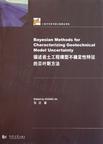描述岩土工程模型不确定性特征的贝叶斯方法
出版时间:2011-11 出版社:同济大学出版社 作者:张洁 页数:161
Tag标签:无
内容概要
As any model is only an abstraction of
the real world, model uncertainty always exists. Ingeotechnical
engineering, the model uncertainty could be large. Lack of
knowledge about modeluncertainty may lead to unrealistic
predictions. When back analysis from observed performances,model
uncertainty is often mixed with parameter uncertainty and
observational uncertainty. Hence itis generally difficult to
isolate and characterize model uncertainty. This book introduces
the state-of-the-art theories and methodologies for geotechnical
model uncertainty characterization based on theBayesian theory,
including both rigorous solution and approximate but practical
solutions, where theeffects of parameter uncertainty and
observational uncertainty on model uncertainty characterizationare
appropriately addressed. The theories and methodologies are
illustrated in detail with variousgeotechnical problems. The book
will be of general interest to readers in the profession
andparticularly useful for those specializing in geotechnical
inverse analysis and geotechnical reliability.
书籍目录
Preface
Chapter 1 Introduction
1.1 Background
1.2 Objective and Scope
1.3 Organization of the Book
Chapter 2 Literature Review
2.1 Within-System Characterization
2.1.1 Least Square Method
2.1.2 Maximum Likelihood Method
2.1.3 Bayesian Method
2.1.4 Extended Bayesian Method
2.1.5 Model Comparison and Multi-model Inference
2.2 Cross System Characterization
2.3 Bayesian Method and Computational Techniques
2.3.1 Maximum Posterior Density Method
2.3.2 First order Second moment Bayesian Method (FSBM)
2.3.3 Laplace Method
2.3.4 System Identification Method
2.3.5 Sampling Based Methods
2.4 Summary
Chapter 3 Bayesian Framework for Characterizing Model Uncertainty
3.1 Parameter, Model, and Observation Uncertainties
3.2 Bayesian Estimation of Model Uncertainty
3.2.1 Extension to Multiplicative Model Correction Factor
3.2.2 Extension to Censored Observed Data
3.2.3 Extension to Model Correction Functions
3.3 Characteristics of Cross System Model Uncertainty
Characterization
3.3.1 Role of Prior Information
3.3.2 Interpretation of Determined Model Uncertainty
3.4 Assignment of Prior Uncertainties
3.4.1 General Guidelines for Determining f(xi)
3.4.2 Prior Distribution for Model Uncertainty Parameters
3.5 Decision Involved in Model Uncertainty Characterization
3.5.1 Selection of Model Correction Factors
3.5.2 Use of Model Correction Function
3.6 Prediction of System Responses
3.7 Possible Solutions to the Bayesian Framework
3.8 Summary
Chapter 4 Simplified Bayesian Framework for Characterizing Model
Uncertainty
4.1 Introduction
4.2 Approximate Formulation for Characterizing Model Uncertainty
4.3 Discussion of Prior Distributions on Model Uncertainty
Parameters
4.4 Characterizing Model Uncertainty based on the Approximate
Formulation
4.4.1 Maximum Posterior Density Method
4.4.2 Grid Calculation Method
4.4.3 MCMC Simulation
4.5 Comparison of Model Uncertainty Factors
4.5.1 Spreadsheet Method
4.5.2 Grid Calculation Method
4.6 Approximate Prediction of System Response
4.7 Extension to Model Correction Functions
4.8 An Illustration Example
4.8.1 Background
4.8.2 Prior Knowledge in Model Uncertainty Parameters
4.8.3 Test Uncertainty
4.8.4 Calculation of μG(x) and σG(x)
4.8.5 Spreadsheet Implementation of the Maximum Posterior
Method
4.8.6 Comparison of Methods for Model Uncertainty
Characterization
4.9 Summary
Chapter 5 Efficient Markov Chain for Identifying Geoteehnieal
Model Uncertainty
5.1 Introduction
5.2 Study of Efficient Markov Chain for Characterizing Model
Uncertainty
5.2.1 Markov Chains under Investigation
5.2.2 Comparison of Markov Chains
5.3 Hybrid Markov Chain for Model Uncertainty Characterization
in the Original Bayesian Framework
5.3.1 Structure of the Hybrid Markov Chain
5.3.2 Determination of the Jumping Functions
5.3.3 Check of Convergence
5.4 Application to the Slope Stability Model Example
5.4.1 Performance of the Markov Chain
5.4.2 Check of Convergence
5.4.3 Posterior Distributions
5.4.4 Accuracy of Approximate Methods
5.5 Extension to Model Correction Function Calibration
5.6 Summary
Chapter 6 Probabilistic Back-Analysis of Slope Failure
6.1 Introduction
6.2 Further Study on Model Uncertainty of Limit Equilibrium
Methods
6.2.1 Effect of Test Uncertainty
6.2.2 Effect of Quality of Test Data
6.2.3 Effect of Amount of Test Data
6.3 Back Analysis of Slope Failure with Unknown Model
Uncertainty
6.3.1 Bayesian Formulation
6.3.2 MCMC Simulation
6.3.3 Response Surface Approximation
6.3.4 Illustrative Example
6.4 Back Analysis of Slope Failure with Known Model Uncertainty
6.4.1 Theory of Back Analysis with Known Model Uncertainty
6.4.2 Step-by-step Implementation
6.4.3 Reanalysis of Shek Kip Mei Landslide
6.5 Summary
Chapter 7 Reliability Based Design of Pile Foundation
7.1 Introduction
7.2 Problem Description
7.3 Model Uncertainty Characterization
7.3.1 Model Uncertainty Characterization Using Approximate
Methods
7.3.2 Model Uncertainty Characterization in the Original
Bayesian Framework
7.3.3 Comparison of Results
7.3.4 Effect of Data Censoring on Model Uncertainty
Characterization
7.3.5 Role of Model Uncertainty in Pile Capacity Prediction
7.4 Comparison of Probabilistic Models for Model Uncertainty
Characterization
7.4.1 Use of Additive Model Correction Factor
7.4.2 Use of Model Correction Functions
7.5 Reliability Based Design of Pile Foundations
7.5.1 Design Point Method
7.5.2 Application to Pile Capacity Model
7.5.3 Adjustment in Consideration of Structural Codes
7.5.4 Regression Analyses of Partial Factors
7.6 Reliability Based Design with Effective Stress Approach
7.7 Comparison of the SPT Method and Effective Stress Method
7.8 Summary
Chapter 8 Characterizing the Model Uncertainty of a Liquefaction
Model
8.1 Introduction
8.2 Problem Description
8.2.1 Liquefaction Model under Investigation
8.2.2 Calibration Database
8.2.3 Parameter Uncertainty
8.3 Determination of Model Uncertainty
8.3.1 Bayesian Formulation
8.3.2 Choice-based Sampling Bias
8.3.3 Prior Probabilistic Analysis of Liquefaction Data
8.3.4 Calibration Results
8.3.5 Role of Model Uncertainty in Liquefaction Potential
Evaluation
8.3.6 Determination of Target Factor of Safety
8.4 Summary
Appendix A
Appendix B
References
图书封面
图书标签Tags
无
评论、评分、阅读与下载
用户评论 (总计1条)
- 翻了一遍,没什么新的东西
推荐图书
相关图书
- Autodesk Revit Structure 2012 应用宝典
- 高等数学
- 宝宝养护一日一指导
- 家书的范要/影响一世的东方智慧妙要
- 儒的思想/影响一世的东方智慧妙要
- 禅的意境/影响一世的东方智慧妙要
- 当代中国边疆·民族地区典型百村调查(第一辑)
- 中华生肖文化与之棋牌
- 校园魔鬼词典
- 影响孩子一生的教子经典-哈佛家训剑桥家训全书
- 赛尔号即时攻略.超级BOSS大攻略
- 赛尔号即时攻略.实战精灵全分析
- 怀孕40周饮食一日一指导
- 孕妈妈保健一日一指导
- 食疗保健200典
- 三字经.百家姓.千字文-领跑者 小学生新课标经典文库-彩图拼音版
- 你能走多远
- 超甜蜜恋爱指令
- 管理者的修养与魅力
- 平凡成就精彩
- 赛尔号即时攻略11
- 语境阅读
- 地理学的性质
- ANSYS结构及动力学分析
- 物流工程
